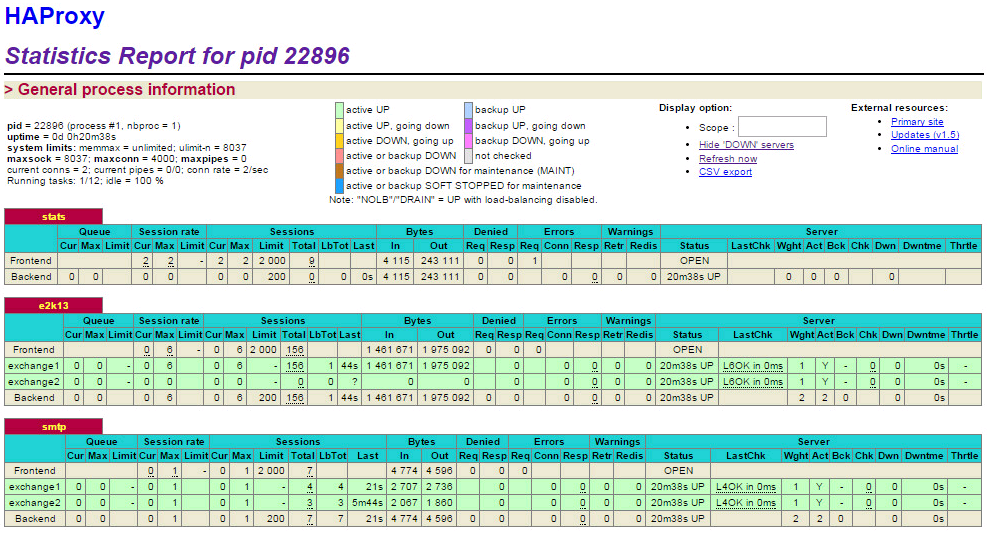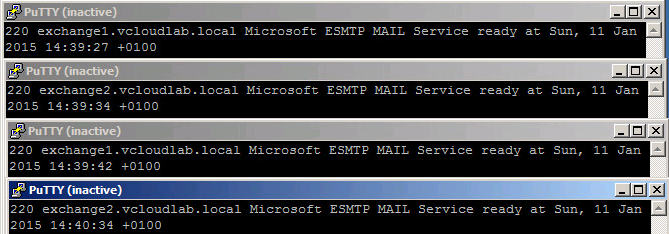Load Balancing inbound SMTP connection with HAProxy
In my last blog post I have highlighted how HAProxy can be used to distribute client connections to two or more servers with Exchange 2013 CAS role. But there is another common use case for load balancers in a Exchange environment: SMTP. Let’s take a look at this drawing:

Patrick Terlisten/ vcloudnine.de/ Creative Commons CC0
The inbound SMTP connections are distributed to two Mail Transfer Agents (often a cluster of appliances, like Cisco IronPort or Symantec Messaging Gateway) and the MTAs forward the e-mails to the Exchange servers. Sometimes the e-mails are not directly forwarded to the Exchange servers, but to mail security appliances instead (like Zertificon Z1 SecureMail Gateway). After the e-mails have been processed by the mail security appliances, they are forwarded to the Exchange backend. Such setups are quite common. If a load balancer isn’t used, the MX records often point to the public IP address of a specific MTA. In this case, two or more MX records have to be set to ensure that e-mails can be received, even if a MTA fails.
A setup with a load balancers allows you to have a single MX record in your DNS, but two or more servers that can handle inbound SMTP connections. This makes maintenance easier und allows you to scale without having to fumble on the DNS. It’s without saying that your Load Balancer should be highly available, if you decide to realize such a setup.
It’s not hard to persuade HAProxy to distribute inbound SMTP connections. All you have to do is to add this to your haproxy.conf. To get the full config, check my last blog post about HAProxy.
mode tcp
no option http-server-close
balance roundrobin
option smtpchk HELO mail.terlisten-consulting.de
server mail1 192.168.200.107:25 send-proxy check
server mail2 192.168.200.108:25 send-proxy check
The “send-proxy” parameter ensures, that the incoming IP address is forwarded to the servers behind the load balancer. This is important if you use Greylisting or real-time blacklists on your MTA or mail server. When running Postfix 2.10 or later, please make sure that you add this line to your main.cf:
smtpd_upstream_proxy_protocol = haproxy
This option add support for the PROXY protocol. Incoming requests are distributed alternating to the servers behind the load balancer. The “balance roundrobin” parameter ensures this. Please make sure that the MTA, that is running on your Linux host, doesn’t listen on the external IP. In my case, Postfix listens only on 127.0.0.1.
[root@haproxy haproxy]# netstat -tulpen
Active Internet connections (only servers)
Proto Recv-Q Send-Q Local Address Foreign Address State User Inode PID/Program name
tcp 0 0 192.168.200.103:25 0.0.0.0:* LISTEN 0 228433 22876/haproxy
tcp 0 0 127.0.0.1:25 0.0.0.0:* LISTEN 0 15431 1309/master
The statistics page can be used to verify the success of the configuration (click the picture to enlarge).

Patrick Terlisten/ vcloudnine.de/ Creative Commons CC0
[caption id=“attachment_2060” align=“alignnone” width=“640”] Patrick Terlisten/ vcloudnine.de/ Creative Commons CC0[/caption]
Patrick Terlisten/ vcloudnine.de/ Creative Commons CC0[/caption]
Alternatively you can use Telnet to connect to the load balancer on port 25/tcp. As you can see in the screenshot, using the FQDN mailin.vcloudlab.local resulted in an alternating connection to the backend servers.

Patrick Terlisten/ vcloudnine.de/ Creative Commons CC0
